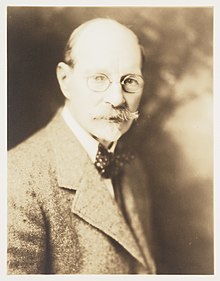Harold Mortimer-Lamb
Harold Mortimer-Lamb | |
|---|---|
 | |
| Born | 21 May 1872 Leatherhead, England |
| Died | 25 October 1970 (aged 98) |
| Occupation | Engineer |
| Children | Molly Bobak, Oliver Mortimer-Lamb |
Harold Mortimer-Lamb (1872 - 1970), a mining engineer, journalist, photographer, and artist.
Early life
Harold Mortimer-Lamb was born in Leatherhead, Surrey England on 21 May 1872. He came to Canada in 1889, settling in British Columbia (B.C.). Most of his professional life was in the mining industry of Canada. He did, however, become interested in photography early on, specializing in soft focus romantic portraits.
Mining engineering
He worked for the Bureau of Information for the B.C. Government. He became Secretary-Treasurer of the Provincial Mining Association of B.C.; Secretary of the Canadian Mining Institute and served on the staff of the Department of Mines in Ottawa. He was the founding editor of the British Columbia Mining Record.[1]
Mortimer-Lamb was appointed Secretary of the Canadian Mining Institute in the early 1900s which required him to relocate to Montreal.
Photography

While living in Montreal, he had the opportunity to meet, and become acquainted with, many of the leading artists of the day including Homer Watson, William Brymner, Maurice Cullen, and later, members of the Group of Seven, in particular A.Y. Jackson. During this time, he also acted as the Montreal correspondent for the leading English art journal, The Studio. As an art critic he wrote in defence of the Group of Seven at a time when most other critics were attacking their work. Around 1920, he left his position at the Mining Institute in Montreal to take up the post of Secretary-Treasurer of the BC Division in Vancouver. In 1926, he opened a gallery on Robson Street with fellow photographer John Vanderpant. Although their association was short-lived, the gallery continued and was a centre for music, poetry, and painting. Among the artists showcased were members of the Group of Seven. After his retirement from the mining industry in 1941, he himself began to paint, his works being exhibited in Montreal and Vancouver.[2]
His work was widely exhibited and he was eventually elected an Honorary Fellow of the Royal Photographic Society. For many years, he also fostered a keen interest in the arts, helping to found a small art club in Victoria and frequently contributing articles on the Canadian art scene to the Canadian Magazine and other periodicals.[2]
Harold Mortimer-Lamb died in Burnaby, BC on 25 October 1970. His daughter is Molly Bobak, well-known Canadian artist.
Publications
- Photograms of the Year (1895 - 9140)[3] with Sidney Carter (artist)
- British Columbia Mining Record (ed.)[1]
See also
Notes and references
- ^ a b Amos 2013, p. 11.
- ^ a b Macdonald 1971, pp. 719–720.
- ^ Lerner & Williamson 1991, p. 121.
- Macdonald, Colin S. (1971). "Lamb, Harold Mortimer". A Dictionary of Canadian Artists: Jacobi to Lismer. Canadian Paperbacks. ISBN 978-0-919554-05-4.
{{cite book}}: Invalid|ref=harv(help) - Amos, Robert (2013). Harold Mortimer-Lamb: The Art Lover. TouchWood Editions. ISBN 978-1-77151-018-9.
{{cite book}}: Invalid|ref=harv(help) - Lerner, Loren R.; Williamson, Mary F. (1991). Art and Architecture in Canada: A Bibliography and Guide to the Literature. University of Toronto Press. ISBN 978-0-8020-5856-0.
{{cite book}}: Invalid|ref=harv(help) - Obee, Dave (10 November 2013). "Books: Art lover helped shape Greater Victoria gallery's collection". Times Colonist. Retrieved 2014-09-29.
{{cite web}}: Invalid|ref=harv(help)
- Tippett, Maria. "Review of Harold Mortimer-Lamb: The Art Lover". BC Studies. Retrieved 2014-09-29.
{{cite web}}: Invalid|ref=harv(help)
External links
![]() Media related to Harold Mortimer-Lamb at Wikimedia Commons
Media related to Harold Mortimer-Lamb at Wikimedia Commons
